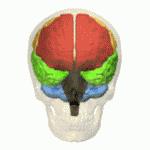Age and antisocial personality disorder
The number of arrests spikes in adolescence, but subsequently declines. This spike leads people to wonder whether more offenders are appearing or more offenses are committed by the same few offenders. Evidence shows that there is an increase in both. The most persistent 5% of offenders are responsible for more than 50% of known crimes committed. [5]
Several experiments have been conducted to investigate the relationship between extremity and stability of offenses. In one such experiment a group of third grade boys was studied. Out of the most aggressive 5%, 39% of them scored above the 95th percentile on aggression ten years later, and 100% of them were above the median. [5]
Aggression and antisocial behavior in a child is a predictor of adult antisocial behavior. [6] Some 'difficult' children exhibit behavioral problems due to neurological dysfunctions. One study looked specifically at neurological damage and infant behavior in 66 low-birth-weight infants from intact middle-class families. These children exhibited traits such as immaturity, overactivity, temper tantrums, poor attention, and poor school performance. Each of the previous traits listed has been linked to antisocial behavior later in life. [5] However, these children were not followed up with later in life to ensure their trajectory into crime. [5]
Continuity and stability of antisocial behavior
The continuity and stability of antisocial behavior lies at the root of Moffitt's theory. The adolescent limited offenders exhibit antisocial behavior without stability over their lifetime, while life-course-persistent offenders typically display antisocial behavior from very early ages. Biting and hitting as early as age 4 followed by crimes such as shoplifting, selling drugs, theft, robbery, rape, and child abuse characterize a life course persistent offender. [5]
Donker et al. presents a test concerning the prediction on the stability of longitudinal antisocial behavior. Two types of antisocial behavior were measured: covert, or behavior that focuses on deceit and theft, and overt, or behavior that involves direct confrontation and the threat of physical harm. This experiment documents subjects during three main periods of their life: childhood, 6–11 years of age, adolescence, 12–17 years of age, and adulthood, 20–25 years of age. Offenders that begin to show antisocial behavior in childhood that continues into adulthood are what Moffitt considers to be life-course-persistent offenders. Their delinquent behavior is attributed to several factors including neuropsychological impairments and negative environmental features. Moffitt predicts that "…estimates of the individual stability of antisocial behavior are expected to violate the longitudinal law, which states that relationships between variables become weaker as the time interval between them grows longer." [5]
The original sample of children (ages 6–11) in 1983 consisted of 1,125 subjects. Three main areas were studied in the subjects: status violations, overt behavior, and covert behavior. Children exhibiting overt behavior were found to have two times greater risk for covert behavior as an adolescent and three times greater risk for it in adulthood. This violates the longitudinal law and proves Moffitt's expectations correct. Further results also supported this violation, but only with respect to overt behavior, not covert behavior. [7] There is a difference in the continuity of antisocial behavior between men and women as well. In one longitudinal study an entire county's population was followed from age 8 to 48. Only 18% of the women who ranked high in antisocial behavior at age 8 rank high at age 48, while 47% of men stay in the high category. About 37% of both men and women, however, retained low antisocial behavior through age 48. [6]

